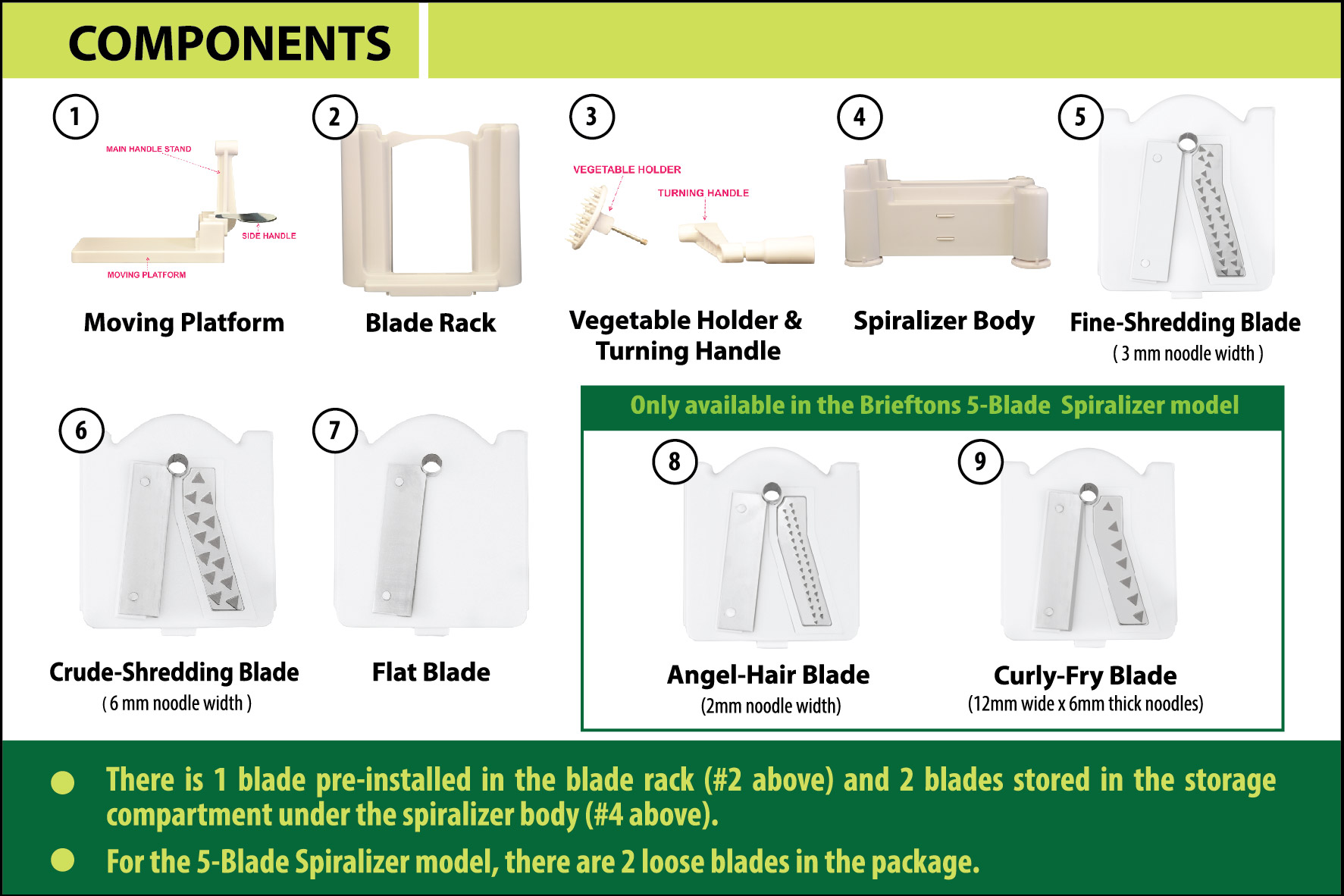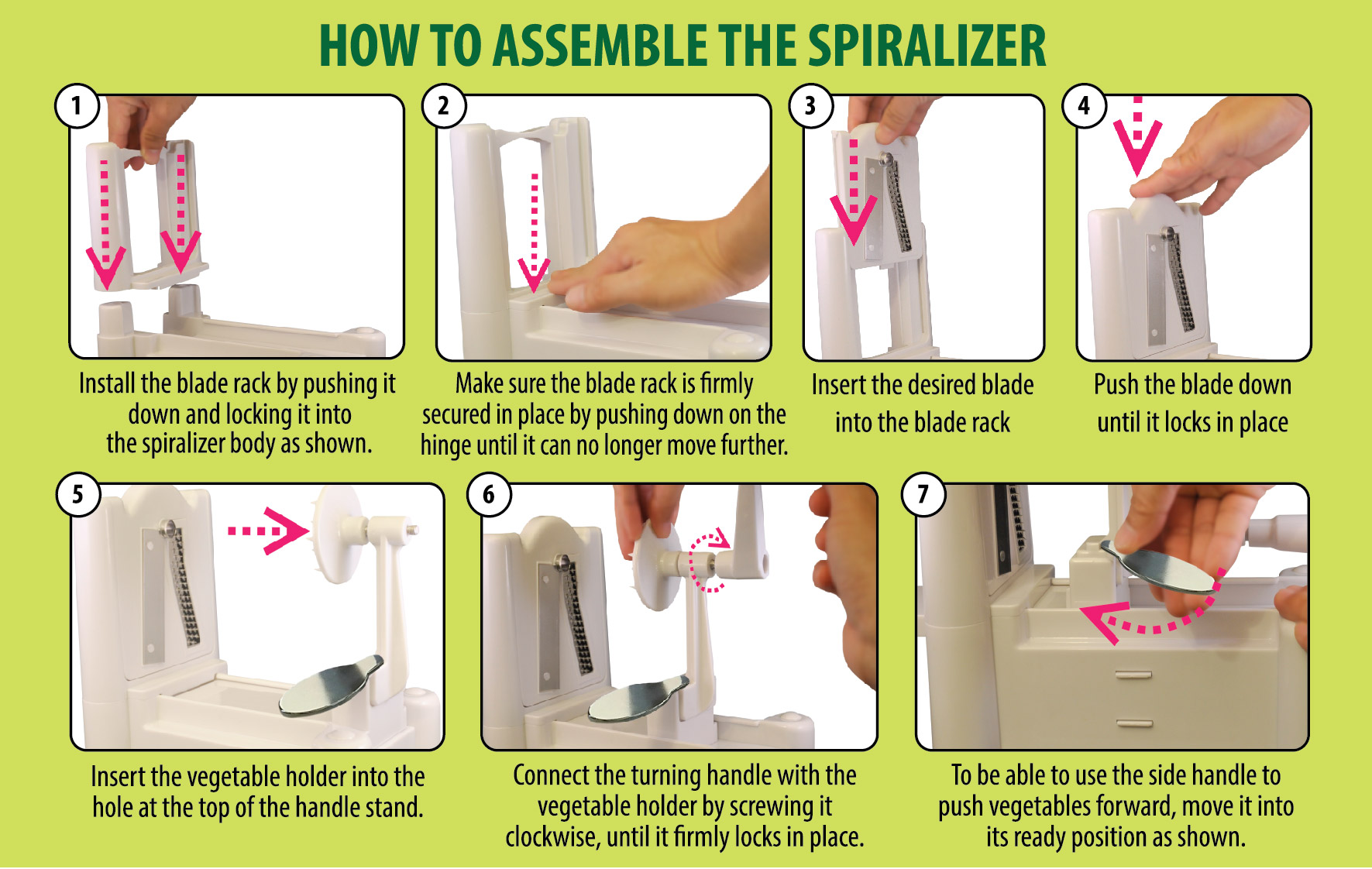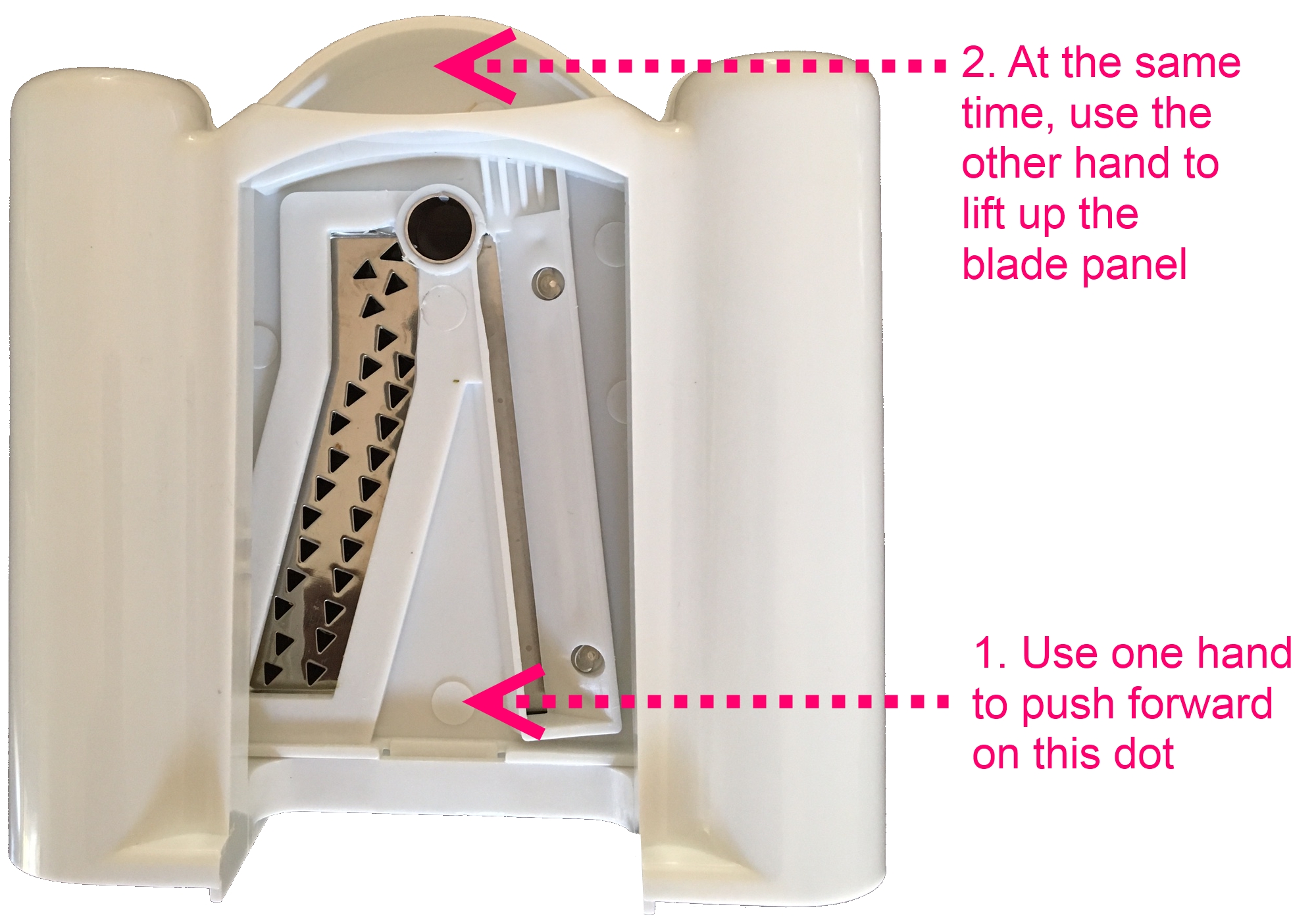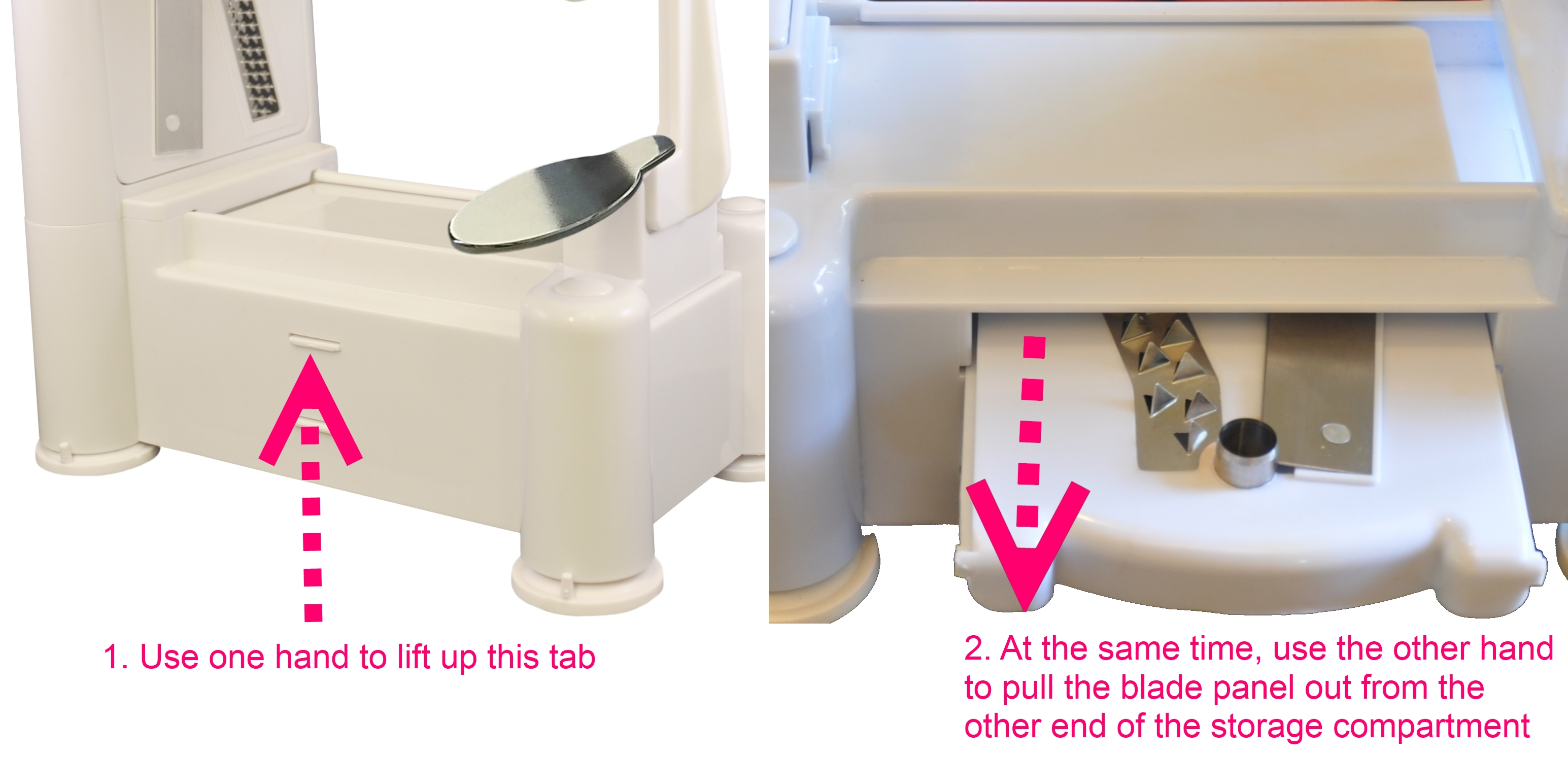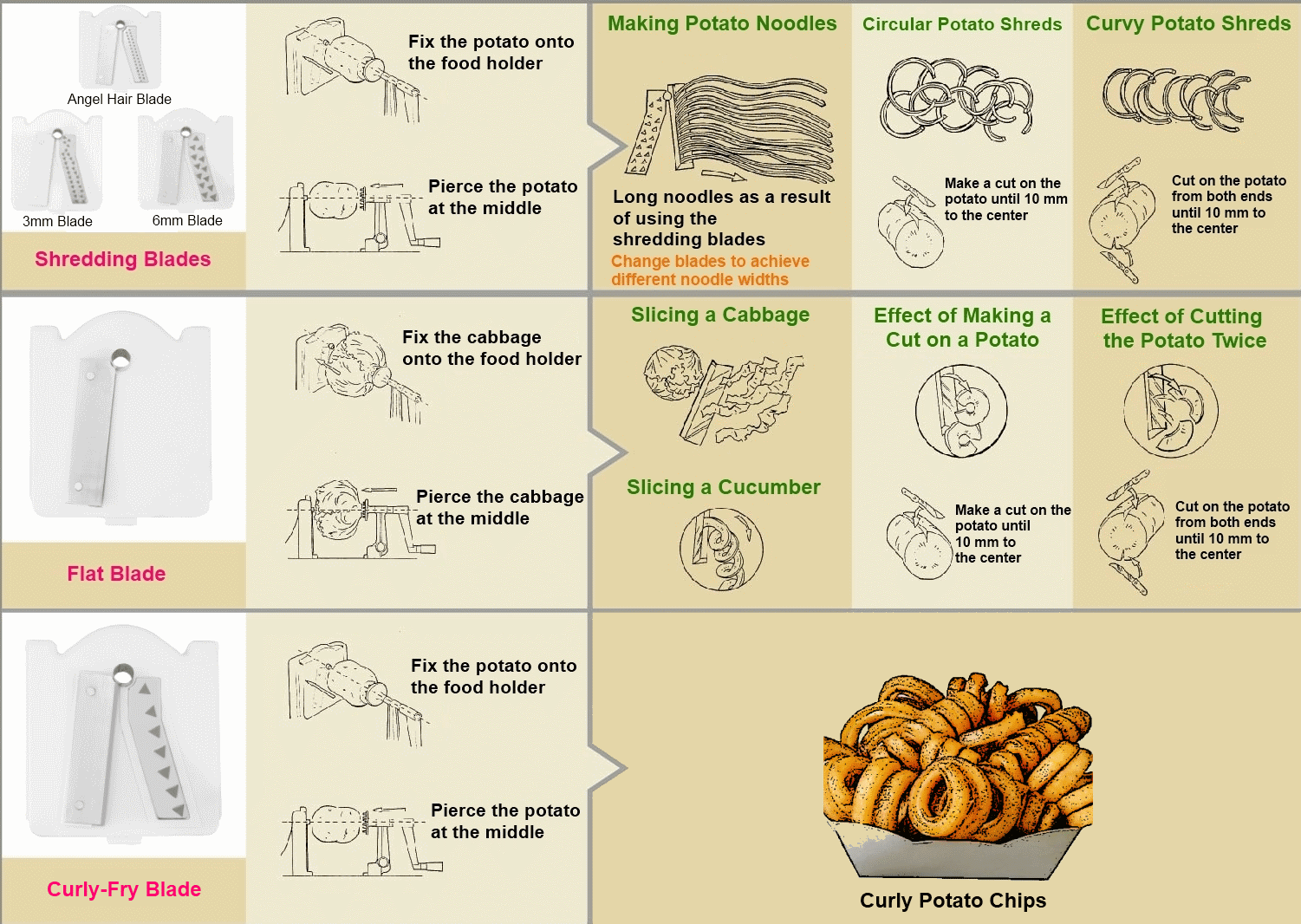Please check out the images, videos and guides below before using your Brieftons 5-Blade Spiralizer (Model: Classic). They will help you use the product correctly. Don’t worry, it’s not as complicated as it looks, as you will soon find out!
Quick Links:
Components
How to Assemble
How to Change Blades
How to Use the Spiralizer
Possible Vegetable Patterns
Examples of How to Spiralize Particular Vegetables/Fruits
How to Clean
Tips
What Vegetables and Fruits Work with the Spiralizer?
What Vegetables and Fruits Don’t Work with the Spiralizer?
What Dishes Can You Make With The Spiralizer
Cooking and Storing Spiralized Vegetables
Full Demo Video
Customers’ Videos
Recipes to Get You Started
Spare Parts
Components
Your 5-Blade Spiralizer (Model: Classic) comes with the following components.
See the demo video showing the components here:
How to Assemble
Before the spiralizer can be used, please take a minute to set it up by following these simple steps…
See the demo video showing how to assemble the product here:
How to Change Blades
IMPORTANT: When your spiralizer is brandnew, it may be a little harder to remove the blades. If you have any difficulty removing the blade from either the standing blade rack or the blade storage compartment, please try the following steps.
How to remove the blade from the standing blade rack
How to remove the blade from the storage compartment
See the demo video showing how to change/remove the blades here:
How to Use the Spiralizer
See the demo video showing how to use the spiralizer here:
Possible Vegetable Patterns
Apart from vegetable noodles, the spiralizer can also create veggie shreds, chips, slices, circular and curvy shreds. Please refer to the below diagram for some examples.
See the video demo showing the possible types of cuts you can achieve with the spiralizer here:
Due to the large number of vegetables that the spiralizer can be used for, it’s not possible to have a definite list of vegetables that should be spiralized for each blade. However the general rules of thumb are:
- Softer vegetables can use any blade
- For harder vegetables such as sweet potato or butternut squash, we recommend the use of a bigger blade e.g. 3mm or 6mm blades. This is because a smaller blade will have more blade teeth which may cause more resistance when used with a harder vegetable
- Vegetables with layers or a hollow inside e.g. onions, cabbages, bell peppers should use the Flat blade
Examples of How to Spiralize Particular Vegetables/Fruits
Most vegetables can be spiralized the same way. However, please follow the following suggestions if you are spiralizing any of the below-mentioned vegetables/fruits…
Apple
Cut off the top, cut off the bottom, and stick the middle part, which is the core of the apple, right on the round steel spindle of the spiralizer. The apple core will be gone in no time. Spiralized apples are great for use in salads, savory dishes and desserts. Spiralized apple will turn brown really quickly so it’s best to use them immediately or dress them with lemon juice.
Artichokes
Large artichokes work best. It’s not necessary to peel them. If you are not using the spiralized artichokes immediately, it’s best to place them in a bowl of water with some lemon juice to prevent them from discoloring.
Beetroot
There’s no need to peel fresh beetroot. Just wash the skin, flatten the ends and spiralize whole. They can be had raw in salads or baked into tasty beetroot crisps.
Bell Pepper
Bell peppers are a little trickier. It’s best to cut off the top and place the open end on the edge of the flat blade, and attach the bottom side to the handle, before spiralizing it.
Broccoli
Don’t throw away broccoli stems, as they can spiralize really well using the smaller blade sizes. For best results, stir fry or steam the spiralized broccoli stems.
Butternut Squash
To avoid the seeds, you should only use the non-bulbous end of the squash. Cut any really long strands of spiralized squash into smaller pieces using scissors, as that will make the spiralized squash easier to eat.
Cabbage
Cabbage is already in layers by nature, so make sure to use the flat blade. Spiralize as usual and you will have shredded cabbage (coleslaw) in no time.
Carrots
Choose large carrots for spiralizing for best results. Eat spiralized carrots raw in salads, or steam carrot ribbons to create a delicious accompaniment.
Celeriac
Use a sharp knife to remove the knobbly bits from the celeriac, peel it, then cut it in half, and trim to create 2 flat ends. Spiralized celeriac works well in gratins, soups and remoulade.
Cucumber
Cucumbers are easy to spiralize, however there’s one issue: the juice. Just spiralize it as usual, then let it sit for a while so that the juice can drain out. Or you can pat the spirals or ribbons dry with a piece of paper towel. Cucumbers make beautiful ribbons for use in salads.
Onions
Onions are already in layers by nature, so make sure to use the flat blade. Spiralize as usual and you will have piles and piles of thinly sliced onion rings in no time. You can use spiralized onions to replace chopped ones in recipes, or turn them into onion bhajis and crispy onion spirals.
Parsnips
Choose large fat parsnips for best results. Add them to a rosti or make parsnip crisps.
Potatoes and Sweet Potatoes
Prepare potatoes or sweet potatoes by peeling them, trim the 2 ends and cut in half widthways if they are very large. Sweet potatoes are great for adding colors to any dish.
Swedes
Peel off the skin, then cut into large chunks with flat ends to attach to the spiralizer. They can be used in fritters or mixed with potatoes as a topping.
Zucchini
Spiralized zucchinis make perfect zoodles. It’s easiest to cut the zucchini in half first before spiralizing it. They can be eaten raw or very lightly steamed, boiled or stir fried.
How to Clean
- Wash the spiralizer under running tap water. Use a mild detergent if necessary. Use a brush to clean between the blade teeth if necessary.
- Hand washing is recommended to prolong the life of the product.
- If washed in a dishwasher, use cold water only, as hot water can warp the suction cups and prevent them from working correctly.
- Sometimes carrots may leave stains on the spiralizer’s plastic. If that happens, try one of the 2 methods below:
- The easier method: Use baking soda to clean the stain.
- The most effective method: Mix a paste of baking soda and dish soap, scrub it on the stain, let it sit for 20 minutes, scrub it again, and rinse it thoroughly. Repeat as necessary until the stain is removed.
Tips
For best results when using the Brieftons 5-Blade Spiralizer, please:
- Choose thick, firm and straight vegetables.
- Place the spiral slicer on an even, flat surface, and make sure to push down on the 4 corners until the suction cups are all secured against the surface.
- Place the vegetable straight in the middle of the vegetable holder, making sure it does not lean heavily toward any particular side.
- Twist the vegetable with a consistent forward motion.
- For vegetables with a skin, peeling the skin off will make it easier to spiralize them.
- For harder vegetables, pre-boiling them first will make it easier to spiralize them.
What Vegetables and Fruits Work with the Spiralizer?
- Produce that is thick, firm, straight, at least 1 1/2 inches long and at least 1 1/2 inches in diameter. Bagged carrots are usually not thick enough. Choose loose carrots as they tend to be wider.
- Possible vegetables are apples, Asian pears, beets, broccoli stems (only fat ones), carrots (only fat ones), celeriac, chayote, cucumbers, daikon radish, jicama, kohlrabi, onions, parsnips, pears, bell peppers, potatoes, radishes, rutabaga, sweet potatoes, turnips, watermelon radishes, winter squash, zucchini and other summer squash.
What Vegetables and Fruits Don’t Work with the Spiralizer?
- Produce that is narrow, like celery or thin carrots.
- Produce that is soft or juicy. The produce will give and fall apart or squish as it is pushed against the blade. Eggplant might seem firm, however the flesh has a spongy texture which will not stay intact when turned on the spiralizer, and it will tear. Pears will work if they are firm, even if they are on the juicy side.
- Produce that is irregular, such as cauliflower and broccoli florets, which are difficult to secure and will fall apart.
- Produce with lots of seeds or one big seed in the middle. The one exception is thick-fleshed bell peppers. You can use the spiralizer for bell peppers, however it’s best to only spiralize a little more than halfway up the vegetable, until the blade reaches the seedpod.
What Dishes Can You Make With The Spiralizer
There are many types of dishes you can make with the spiralizer. For ideas, the Brieftons Spiral Slicer Recipe eBook is a good starting point.
Here are just some examples of what you can make…
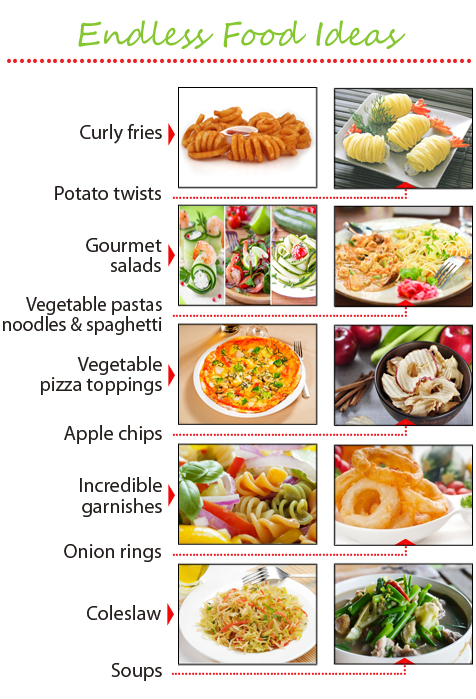
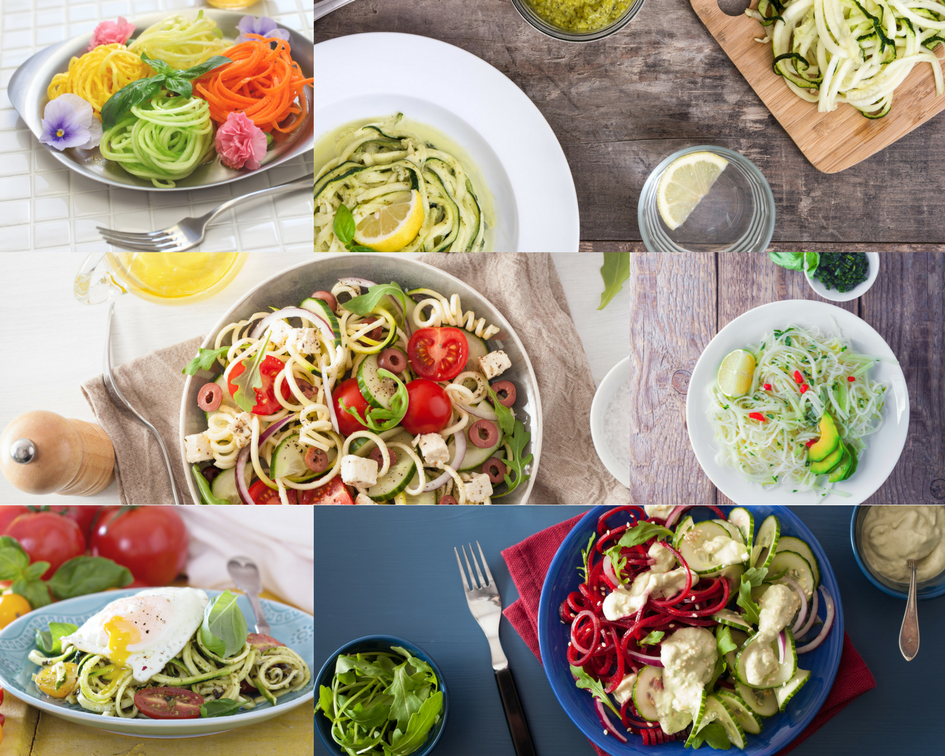
Cooking and Storing Spiralized Vegetables
The good thing about spiralized vegetables is they can be cooked really quickly or even eaten raw. The best ways to cook them are usually the simplest:
- Steaming
- Simmering in boiling water
- Stir frying
- Baking and roasting (for spiralized vegetables such as sweet potatoes, potatoes, beetroots, parsnips and butternut squash)
It’s perfectly fine to store most spiralized vegetables in an airtight container in the fridge for 3-4 days. This means you can prep vegetables in advance, or spiralize extra and save the rest for later use. There are some exceptions though:
- Apples, pears and potatoes can oxidize quickly and turn brown, so it’s best to prepare them as and when needed.
- Spiralized cucumber can only be kept for 2 days because of its high water content.
Full Demo Video
Please find below the full demo video showing the Brieftons 5-Blade Spiralizer (Model: Classic) in action, and demonstrating its correct use.
Customers’ Videos
These videos show how some Brieftons customers use their 5-blade spiralizers. They contain many good tips from a customer’s perspective.
Recipes to Get You Started
Have you downloaded your copy of the Brieftons Spiral Slicer recipe ebook? It contains 20 quick, healthy & tasty vegetable dishes that you can make with your spiralizer right away…
Click Here to Get the Brieftons Spiral Slicer Recipe eBook
Spare Parts
The following spare parts are available for the Brieftons 5-Blade Spiralizer (Model: Classic). Visit the links to order them from Amazon.com:
- Pack of 4 suction cups
- Pack of 2 premium blades (2mm Angel-Hair blade, Curly-Fry blade)
- Pack of 3 standard blades (3mm blade, 6mm blade and flat slicing blade)
- Pack of a vegetable holder and a turning handle
Got a minute? Tell us (and other shoppers) about your experience with your Brieftons 5-Blade Spiralizer (Model: Classic) when you leave a product review.
Have questions? Need help? Just contact us via support@brieftons.com and you’ll have our full attention!

